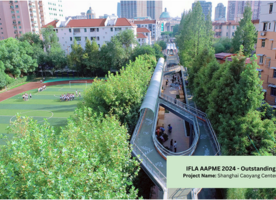News
Landscape Review Journal
Posted 20 12 2023
in News

A New Chapter Begins
The most recent Issue of Landscape Review is now available for reading. A new editorial team has recently been onboarded, and Gill Lawson, Associate Professor of Landscape Architecture, at the School of Landscape Architecture, Lincoln, shared news about a new direction for the journal. Read her Foreward to the new issue below:
The aim of the most recent issue of Landscape Review is to turn the page on yet another chapter in the development of this landmark publication in landscape architecture. Having learned about the evolution of the goals of Landscape Review from Emeritus Professor Simon Swaffield and Professor Jacky Bowring, the new editorial team is repositioning the journal a little closer to home, in Oceania, a slight shift in the geospatial scope for us from the whole of the southern hemisphere to Australia, Aotearoa New Zealand and the Pacific Islands.
This focus seems more achievable, timely, relevant, and strategic at this point for our profession and discipline, although our international aspirations remain steadfast. Our part of the world is unique in many ways: we are an archipelago of island nations and territories; our First Nations peoples are diverse and important to us; we have inherited legacies from British, French and Dutch colonisations; the Pacific Ocean and our maritime responsibilities are a critical part of what we do; and our region is flanked by the two most significant geopolitical powers of the twenty-first century, the United States of America and China. As landscape architects, we are also caught up in a global revolution of contested information, knowledge exchange and machine-learning.
Our new Editorial Board reflects these interests and concerns for our region. We are therefore keen to traverse the discursive space between practice and research in Oceania with our authors, reviewers, editors and readers in this and coming issues. This issue of Landscape Review opens up a discussion about bridging the apparent divide between professional practice and academic research in landscape architecture. The impetus for this theme stems from recent shifts in professional practice and higher education following the abatement of the COVID-19 pandemic. Many of us have experienced a divergence in our understanding of goals, perspectives and outcomes related to both of these sides of landscape architecture. Nevertheless, some landscape architects straddle this divide by undertaking projects underpinned by research approaches and critical thinking. Others take up practice itself as research, reflecting the multiple ways of expanding landscape architectural knowledge production in these volatile, uncertain, complex and ambiguous times. The first two papers in this issue are critical provocations about what we could or should consider as knowledge bases for our discipline and profession. The other three provide valuable examples of integrating research with practice using design thinking, horticultural expertise and local knowledge in key projects.
A summary of the articles included in this issue is below:
Emeritus Professor Peter Downton presents us with his so-called rumination on experimenting with self-remodelling practitioners as researchers.
Associate Professor Katherine Melcher states that landscape architecture research has focused on the development of ‘knowing-what’ or ‘knowing-that’ – that is, substantive knowledge – over the past decades. In this article, she advocates for the development of ‘knowing-how’.
Associate Professor Jillian Walliss and Dr Heike Rahmann explain how the Landscape Architects as Changemakers project arose from the limitations of translation in investigating how Japanese designers work.
Dr Wendy Walls and Dr Brent Greene demonstrate how the Woody Meadows project in greater Melbourne revealed the challenges of integrating experimental horticultural research (for climate resilience, reduced labour and financial inputs, and striking visual appeal) into landscape architectural design work in Australia’s public realm.
Professor Ray Green addresses impassioned complaints from local community members about how the ‘character’ of their coastal ‘sea change’ towns and neighbourhoods is being degraded by accelerated urban growth and development. He illustrates how people living in these settings experience environmental change and its impacts on their sense of place.
We hope that the papers in this issue will provoke other authors to have their say.
10 Dec
Proposed replacement of the RMA: Planning Bill and Natural Environment Bill

A message from the Environmental Legislation Working Group
On Tuesday this week, the Government released proposed bills to replace the Resource Management Act 1991. Reform of our planning …
03 Dec
Newly Registered Landscape Architects 2025

Celebrating professional achievement across Aotearoa The 2025 Registration process is now nearing completion, and we are delighted to acknowledge the …
02 Dec
2025 IFLA APR Newsletter

November Edition
2025 IFLA APR Newsletter: November Edition November brings exciting updates from across the region. We’re welcoming the new IFLA APR …
Events calendar
Full 2025 calendar